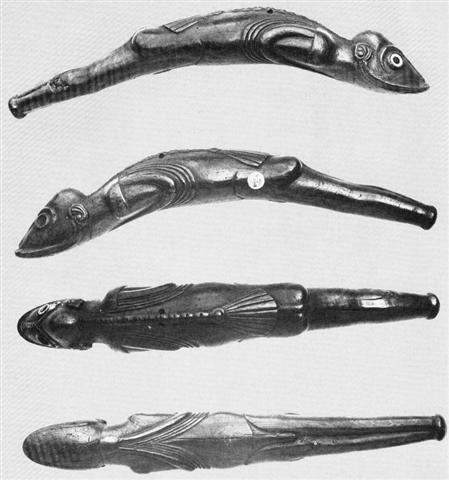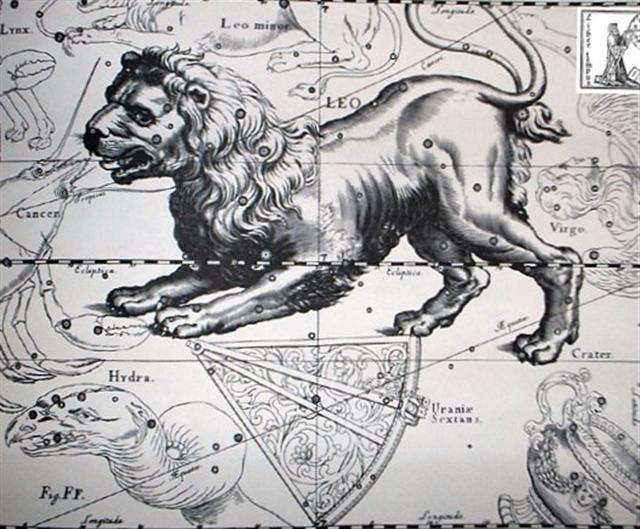108. In the C text we should now try to go back 180
glyphs from Altair in Cb4-20 (483 = 3 * 161) in order to
find the leading (first Greek lettered) star in Cancer,
viz. to MAY 16:
Which at the time of rongorongo corresponded
to day 136 + 64 = 200 (July 19). On Easter
Island the winter month of July was as dark
as January
north of the equator - a bad place (inoino).
|
Kino 1.
Bad; kikino, very bad,
cursed; kona kino, dangerous
place. 2. blemish (on body).
Kinoga, badness, evil,
wickedness; penis. Kinokino,
badly made, crude: ahu kinokino,
badly made ahu, with coarse,
ill-fitting stones. Vanaga.
1. Bad, wrong. T
Pau.: kiro, bad, miserable.
Mgv.: kino, to sin, to do
evil. Mq.: ino, bad,
abominable, indecent. Ta.: ino,
iino, bad, evil; kinoga
(kino 1) sin; Mgv.: kinoga,
sin, vice. 2. A skin eruption,
verruga, blotched skin, cracked feet
T. Churchill. |
|
MAY
7 |
8 |
9 |
10 (130) |
 |
 |
 |
 |
|
Ca11-10 (310 - 16) |
Ca11-11
(295) |
Ca11-12 |
Ca11-13 |
|
etoru inoino |
hakahagana hia to
rima - te inoino |
|
July 10 (191) |
11 |
12 |
13 |
|
'June 14 (164) |
15 |
16 |
17 |
|
"May 30 (150) |
31 |
1 |
2 |
|
MAY 11 |
12 |
13 |
14 |
15 |
16 (136) |
 |
 |
 |
 |
 |
 |
|
Ca11-14 |
Ca11-15 |
Ca11-16 |
Ca11-17 |
Ca11-18 |
Ca11-19 |
|
tupu toona rakau i
te vai |
te moko |
te marama |
te kava |
ihe manu kara
etahi |
te mauga e hiku
hia |
|
July 14 |
15
POLLUX
(*116) |
16
AZMIDISKE (Ξ in ARGO NAVIS)
|
17
Φ Gemini (*118) |
18
DRUS (Χ in ARGO NAVIS) |
19 (200)
Ω CANCRI (*120) |
|
'June 17 |
18 |
19 |
20 |
SOLSTICE |
22 (173) |
|
"June
3 |
4 |
5 |
6 |
7 |
8 (159) |
|
Hiku
Tail; caudal fin. Hikukio'e,
'rat's tail': a plant (Cyperus
vegetus). Vanaga.
...
In the deep night before the image
[of Lono] is first seen,
there is a Makahiki ceremony
called 'splashing-water' (hi'uwai). Kepelino
tells of sacred chiefs being carried
to the water where the people in
their finery are bathing; in the
excitement created by the beauty of
their attire, 'one person was
attracted to another, and the
result', says this convert to
Catholicism, 'was by no means good'
...
(Islands of History) |
 |
 |
 |
|
Ca11-20 |
Ca11-21 |
Ca11-22 |
|
te inoino |
te hokohuki |
te moko |
 |
 |
 |
 |
|
Ca11-23 |
Ca11-24 |
Ca11-25 |
Ca11-26 (310) |
|
te inoino erua |
te hokohuki |
te moko |
At a certain time they made feast and buried
Te Moko - a painted coral stone:
...
A
une certaine saison, on amassait des vivres,
on faisait fête On emmaillotait un corail,
pierre de défunt lezard, on l'enterrait,
tanu. Cette cérémonie était un point de
départ pour beacoup d'affaires, notamment de
vacances pour le chant des tablettes ou de
la priére, tanu i te tau moko o tana pure,
enterrer la pierre sépulcrale de lézard de
sa prière
...
 
The implication was probably
a descent down into the Underworld, a way to
continue the recycling from one generation
to the next:
... He continued travelling until he reached
the house of Uetonga, whose name all
men know: he was the tattoo expert of the
world below, and the origin and source of
all the tattoo designs in this world.
Uetonga
was at work tattooing the face of a chief.
This chief was lying on the ground with his
hands clenched and his toes twitching while
the father of Niwareka worked at his
face with a bone of many sharpened points,
and Mataora was greatly surprised to
see that blood was flowing from the cheeks
of that chief. Mataora had his own
moko, it was done here in the world
above, but it was painted on with ochre and
blue clay. Mataora had not seen such
moko as Uetonga was making,
and he said to him, 'You are doing that in
the wrong way, O old one. We do not do it
thus.'
'Quite so,' replied Uetonga, 'you do
not do it thus. But yours is the way that is
wrong. What you do above there is tuhi,
it is only fit for wood. You see,' he said,
putting forth his hand to Mataora's
cheek, 'it will rub off.' And Uetonga
smeared Mataora's make-up with his
fingers and spoiled its appearance. And all
the people sitting round them laughed, and
Uetonga with them
...

.. When
the man, Ulu, returned to his wife
from his visit to the temple at Puueo,
he said, 'I have heard the voice of the
noble Mo'o, and he has told me that
tonight, as soon as darkness draws over the
sea and the fires of the volcano goddess,
Pele, light the clouds over the crater
of Mount
Kilauea, the black cloth will cover my
head. And when the breath has gone from my
body and my spirit has departed to the
realms of the dead, you are to bury my head
carefully near our spring of running water.
Plant my heart and entrails near the door of
the house. My feet, legs, and arms, hide in
the same manner. Then lie down upon the
couch where the two of us have reposed so
often, listen carefully throughout the
night, and do not go forth before the sun
has reddened the morning sky. If, in the
silence of the night, you should hear noises
as of falling leaves and flowers, and
afterward as of heavy fruit dropping to the
ground, you will know that my prayer has
been granted: the life of our little boy
will be saved.' And having said that, Ulu
fell on his face and died.
His wife
sang a dirge of lament, but did precisely as
she was told, and in the morning she found
her house surrounded by a perfect thicket of
vegetation. 'Before the door,' we are told
in Thomas Thrum's rendition of the legend,
'on the very spot where she had buried her
husband's heart, there grew a stately tree
covered over with broad, green leaves
dripping with dew and shining in the early
sunlight, while on the grass lay the ripe,
round fruit, where it had fallen from the
branches above. And this tree she called
Ulu (breadfruit) in honor of her
husband. The
little spring was concealed by a succulent
growth of strange plants, bearing gigantic
leaves and pendant clusters of long yellow
fruit, which she named bananas. The
intervening space was filled with a
luxuriant growth of slender stems and
twining vines, of which she called the
former sugar-cane and the latter yams; while
all around the house were growing little
shrubs and esculent roots, to each one of
which she gave an appropriate name. Then
summoning her little boy, she bade him
gather the breadfruit and bananas, and,
reserving the largest and best for the gods,
roasted the remainder in the hot coals,
telling him that in the future this should
be his food. With the first mouthful, health
returned to the body of the child, and from
that time he grew in strength and stature
until he attained to the fullness of perfect
manhood.
He became a mighty warrior in those days,
and was known throughout all the island, so
that when he died, his name, Mokuola,
was given to the islet in the bay of Hilo
where his bones were buried; by which name
it is called even to the present time
...

The Moko season could
perhaps have began in June 2 and ended at
the Nose of the Lion, 6 days after Acubens:
 |
| Ca9-27 (255) |
| etoru gagata hakaariki kia raua |
| June 1 (152) |
 |
 |
 |
| Ca10-1 (256) |
Ca10-2 |
Ca10-3 |
| Erua inoino |
kua hua te vai |
 |
 |
 |
 |
| Ca10-4 |
Ca10-5 (260) |
Ca10-6 (9 * 29) |
Ca10-7 |
| te kiore - te inoino |
kua oho te rima kua kai - ihe nuku hoi |
Tupu te toromiro |
kua noho te vai |
 |
 |
 |
 |
 |
| Ca10-8 |
Ca10-9 (264) |
Ca10-10 |
Ca10-11 |
Ca10-12 |
| te moko |
te marama |
te kava |
manu rere |
te mauga tuu toga |
 |
 |
| Ca10-13 (268) |
Ca10-14 |
| kua tupu te mea - i te inoino |
ka tupu te toromiro - i te inoino |
 |
 |
 |
 |
 |
| Ca10-15 |
Ca10-16 |
Ca10-17 (272) |
Ca10-18 |
Ca10-19 |
| rima heu ki te vai |
te moko oho mai |
te marama |
te kava |
manu rere |
|





























